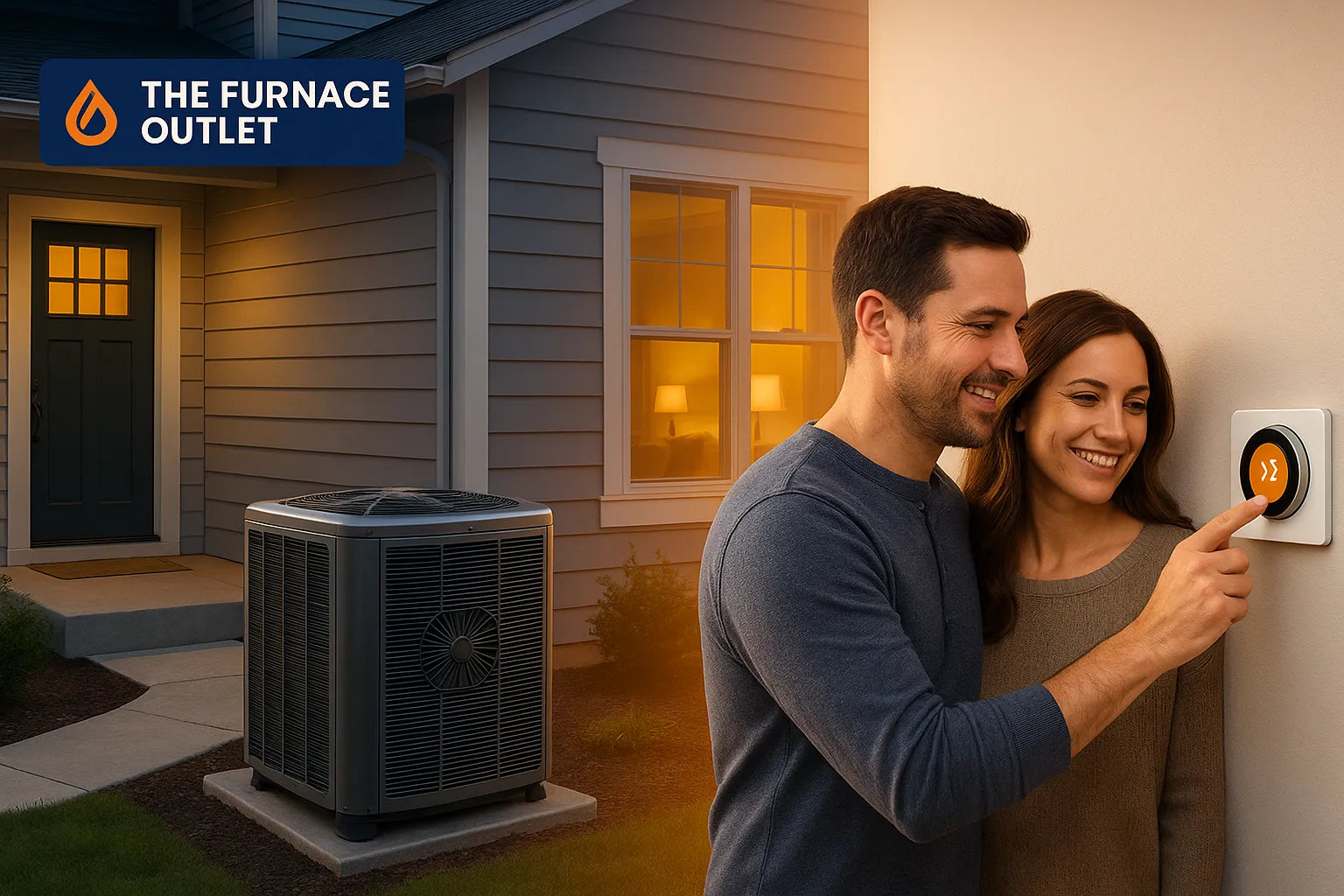Why This Decision Matters
Choosing between a furnace and a heat pump isn’t just a technical exercise, it shapes your comfort, budget, and even resale value. In much of the U.S., heating eats up the largest slice of a household’s energy bill. Picking the wrong system can lock you into higher monthly costs for 15 – 25 years. We’ll walk through the big factors, climate, fuel prices, and home design, so you can make a call that feels obvious, not risky.
If you’d like a quick sanity check while you read, the Design Center at The Furnace Outlet offers no‑pressure guidance from licensed pros.
How Each System Works in Plain English
A heat pump acts like a reversible fridge: in winter it pulls outdoor heat indoors; in summer it pushes heat out. Because it’s moving heat instead of making it, efficiency can top 200–400%. Modern “cold‑climate” models even work below 0 °F. A furnace burns natural gas or uses electric coils to create new heat, then blows it through your ducts. Gas furnaces handle deep freezes without breaking a sweat but only heat, you’ll still need separate cooling.
If you’d rather keep one box outside, check the R‑32 heat‑pump line‑up; for classic gas reliability.
Upfront Cost vs. Long‑Term Budget
Heat pumps start around $3,500 and climb past $20,000, depending on size and whether you choose ducted, ductless, or packaged units. They cost less to run in most warm or moderate states because they sip electricity. Gas furnaces range from roughly $2,000 to $24,000 installed. While cheaper to buy, their fuel bill may run higher if local natural‑gas prices spike. Electric furnaces are the bargain bin up front but the costliest to operate almost everywhere.
To compare apples to apples, price out both equipment and 15 years of fuel in your ZIP code. The Help Center has free calculators to get you started.
Climate Check: Match Your System to Your State
Your winter lows are the first filter. Warm‑winter states like Florida, Texas, and coastal California rarely dip below 40 °F, letting heat pumps run at peak efficiency year‑round. Midwest and Northeast states face prolonged freezes; here, gas furnaces still dominate unless your home is tightly sealed and you install a cold‑climate unit with backup heat strips. In mountain or Great Plains regions where temps whiplash, dual‑fuel packaged units, a heat pump paired with a gas burner, can optimize both comfort and cost.
Browse residential dual‑fuel packages if you straddle seasons.
Energy Prices: Reading Your Gas and Electric Bills
Fuel costs vary more than weather. Natural gas is the cheaper heat source in about 41 states right now, but that edge disappears if local electricity is solar‑heavy or you generate power with rooftop panels. Scan a year of utility statements: if gas costs less than $1.20 per therm and electricity tops $0.15 per kWh, a furnace often wins. If prices flip, a heat pump usually pulls ahead. Remember to factor in shoulder‑season cooling; if you’d need to buy a new air conditioner soon, the combined cost may tilt in favor of a heat pump.
State Snapshots: Where Heat Pumps Shine
Warm states (AZ, CA, FL): Heat pumps supply gentle heat and dependable cooling—no gas line required.
Southeast & coastal Mid‑Atlantic: Moderate winters mean minimal backup heat, so operating costs stay low
Pacific Northwest: Electric grids are hydro‑rich; swapping to a heat pump can slash emissions alongside bills.
For easy installs, many homeowners pick ductless mini‑splits that handle a room or zone without adding new ductwork.
State Snapshots: Where Furnaces Still Rule
Upper Midwest & Northern Plains (ND, MN, WI, MT): Weeks below 0 °F make combustion heat the safe bet.
Gas‑rich states (PA, OH, OK): Abundant, low‑cost natural gas keeps per‑BTU prices down.
Homes with poor insulation: A furnace’s high supply‑air temperature masks drafts that would chill a heat‑pump system.
If cooling isn’t a priority, a simple two‑stage gas furnace may deliver the best comfort‑to‑dollar ratio. Check package units if you also want rooftop simplicity.
Cold‑Climate Heat Pumps: Game‑Changer or Hype?
Next‑gen variable‑speed compressors, vapor‑injection technology, and enhanced refrigerants let advanced units pull heat even at −15 °F. Field studies in Vermont and Minnesota show annual efficiencies above 250% when paired with good air‑sealing. The catch? You need careful sizing and a backup source for polar vortex nights. Done right, you can trim gas use by 60% or more without sacrificing comfort.
Want to see models rated for polar climates? Explore R‑32 packaged systems with cold‑weather certifications.
Making the Call for Your Home
Before you order equipment, gather three data points:
-
Manual J load—your true heating and cooling demand.
-
Fuel price forecast—ask your utility or state energy office.
-
Rebate stack—federal tax credits plus state, utility, or manufacturer incentives.
With those in hand, request bids for both a furnace and a heat‑pump configuration. Compare the net‑present cost over 15 years, including maintenance.
Unsure how to decode the estimates? Tap the Contact Us team; they’ll translate contractor jargon into plain language.
Next Steps and Trusted Resources
A system swap is the perfect time to fix duct leaks, add insulation, or upgrade your thermostat. Many states now bundle weatherization rebates with equipment incentives, so stacking projects can double your savings. If you manage rental units or small hotels, look into PTAC and VTAC solutions that combine heat‑pump efficiency with plug‑and‑play maintenance. Whatever path you pick, keep all paperwork—most warranties and tax credits require proof of proper sizing and commissioning.
Tips for Smart Buyers
-
Start with a load calculation—never size equipment by square footage alone.
-
Check local rebates before signing a contract; incentives can cover 10–30 % of costs.
-
Seal ducts first to let a smaller, cheaper system do the same job.
-
Plan for future cooling even if you’re focused on heat today; climate and comfort needs evolve.
-
Schedule annual maintenance—a $100 tune‑up can prevent thousand‑dollar repairs down the road.







